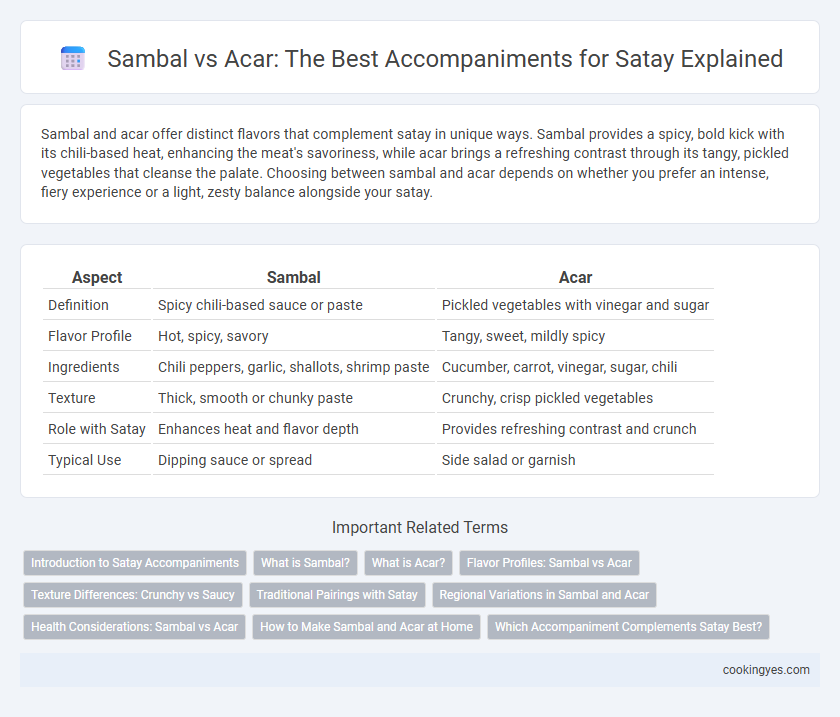Sambal and acar offer distinct flavors that complement satay in unique ways. Sambal provides a spicy, bold kick with its chili-based heat, enhancing the meat's savoriness, while acar brings a refreshing contrast through its tangy, pickled vegetables that cleanse the palate. Choosing between sambal and acar depends on whether you prefer an intense, fiery experience or a light, zesty balance alongside your satay.
Table of Comparison
| Aspect | Sambal | Acar |
|---|---|---|
| Definition | Spicy chili-based sauce or paste | Pickled vegetables with vinegar and sugar |
| Flavor Profile | Hot, spicy, savory | Tangy, sweet, mildly spicy |
| Ingredients | Chili peppers, garlic, shallots, shrimp paste | Cucumber, carrot, vinegar, sugar, chili |
| Texture | Thick, smooth or chunky paste | Crunchy, crisp pickled vegetables |
| Role with Satay | Enhances heat and flavor depth | Provides refreshing contrast and crunch |
| Typical Use | Dipping sauce or spread | Side salad or garnish |
Introduction to Satay Accompaniments
Satay is traditionally served with a variety of accompaniments that enhance its rich, grilled flavor, with sambal and acar being two popular choices. Sambal, a spicy chili paste made from a blend of peppers, garlic, and other spices, adds a bold, fiery kick that complements the smoky meat perfectly. Acar, a tangy pickled vegetable relish made from cucumbers, carrots, and shallots, provides a refreshing contrast by balancing the richness of satay with its crisp acidity.
What is Sambal?
Sambal is a spicy chili paste originating from Indonesia, made primarily with ground chili peppers, garlic, shallots, and vinegar, providing a bold and tangy heat that complements satay's grilled meat flavors. This condiment adds a fiery complexity and depth, enhancing the savory taste without overpowering the dish. Unlike acar, a mild and tangy pickled vegetable relish, sambal offers intense heat and robust spice, making it a preferred accompaniment for those who enjoy a more vibrant and piquant satay experience.
What is Acar?
Acar is a tangy, pickled vegetable relish commonly served as an accompaniment to satay, featuring ingredients like cucumbers, carrots, shallots, and chili peppers preserved in vinegar and sugar. This Malaysian and Indonesian condiment offers a refreshing contrast to the smoky, grilled flavors of satay by adding a sweet and sour crunch. Unlike sambal, which is a spicy chili paste known for its heat and bold flavor, acar provides a milder, cooling balance that enhances the overall satay experience.
Flavor Profiles: Sambal vs Acar
Sambal offers a bold, spicy, and tangy flavor profile with chili peppers, garlic, and lime, enhancing satay with heat and depth. Acar provides a refreshing contrast through pickled vegetables, featuring a balance of sourness and sweetness that cuts through the richness of grilled meat. Together, these accompaniments highlight satay's complex taste by combining fiery intensity with crisp, tangy brightness.
Texture Differences: Crunchy vs Saucy
Sambal offers a saucy, smooth texture that complements satay by adding a spicy moisture, enriching each bite with bold, fiery flavors. Acar, in contrast, provides a crunchy, pickled vegetable texture that cuts through the richness of satay, delivering a refreshing and tangy contrast. These distinct textures balance satay's charred meat, enhancing the overall sensory experience with either vibrant sauciness or crisp acidity.
Traditional Pairings with Satay
Sambal, a spicy chili paste made from ground chilies, garlic, and shrimp paste, is a traditional accompaniment to satay that enhances its smoky grilled flavors with bold heat and umami. Acar, a pickled vegetable relish typically consisting of cucumbers, carrots, and shallots, offers a refreshing, tangy contrast that balances the richness of satay meat. Both sambal and acar hold essential roles in Southeast Asian cuisine, providing complementary taste profiles that elevate the overall satay experience.
Regional Variations in Sambal and Acar
Sambal and acar are popular accompaniments for satay, showcasing distinct regional variations that enhance the dish's flavor profile. In Indonesia, sambal often features spicy chili paste enriched with ingredients like shrimp paste, lime, and garlic, while in Malaysia, it incorporates sweeter, tamarind-based notes. Acar, a pickled vegetable relish, varies from tangy cucumber and carrot mixes in Indonesia to more vinegar-forward versions in Malaysia, providing a refreshing contrast to the rich, grilled meat of satay.
Health Considerations: Sambal vs Acar
Sambal, a spicy chili paste rich in capsaicin and antioxidants, can boost metabolism and provide anti-inflammatory benefits but may irritate sensitive stomachs due to its heat and acidity. Acar, a pickled vegetable relish, offers probiotics and fiber that support digestion and gut health while being lower in calories and milder on the digestive system. Choosing between sambal and acar as satay accompaniments depends on individual tolerance to spice and digestive health goals.
How to Make Sambal and Acar at Home
Sambal, a spicy chili paste made from fresh red chilies, garlic, shallots, and shrimp paste, is typically prepared by grinding ingredients together and sauteing with oil to enhance its flavors. Acar, a tangy pickled vegetable condiment, is created by marinating cucumbers, carrots, and shallots in a mixture of vinegar, sugar, and salt, allowing the vegetables to absorb the sweet and sour balance. Both sambal and acar complement satay by adding heat and acidity, enriching the dish with contrasting tastes and textures.
Which Accompaniment Complements Satay Best?
Sambal, a spicy chili paste with a rich, tangy flavor, enhances satay by adding a bold, savory kick that complements the grilled meat's smoky taste. Acar, a pickled vegetable relish, offers a refreshing, tangy contrast that balances satay's richness with its crisp texture and subtle sweetness. While sambal intensifies satay's heat and depth, acar provides a cooling effect, making the best accompaniment choice dependent on whether you prefer a spicy or a more refreshing flavor profile.
Sambal vs acar for satay accompaniments Infographic

 cookingyes.com
cookingyes.com